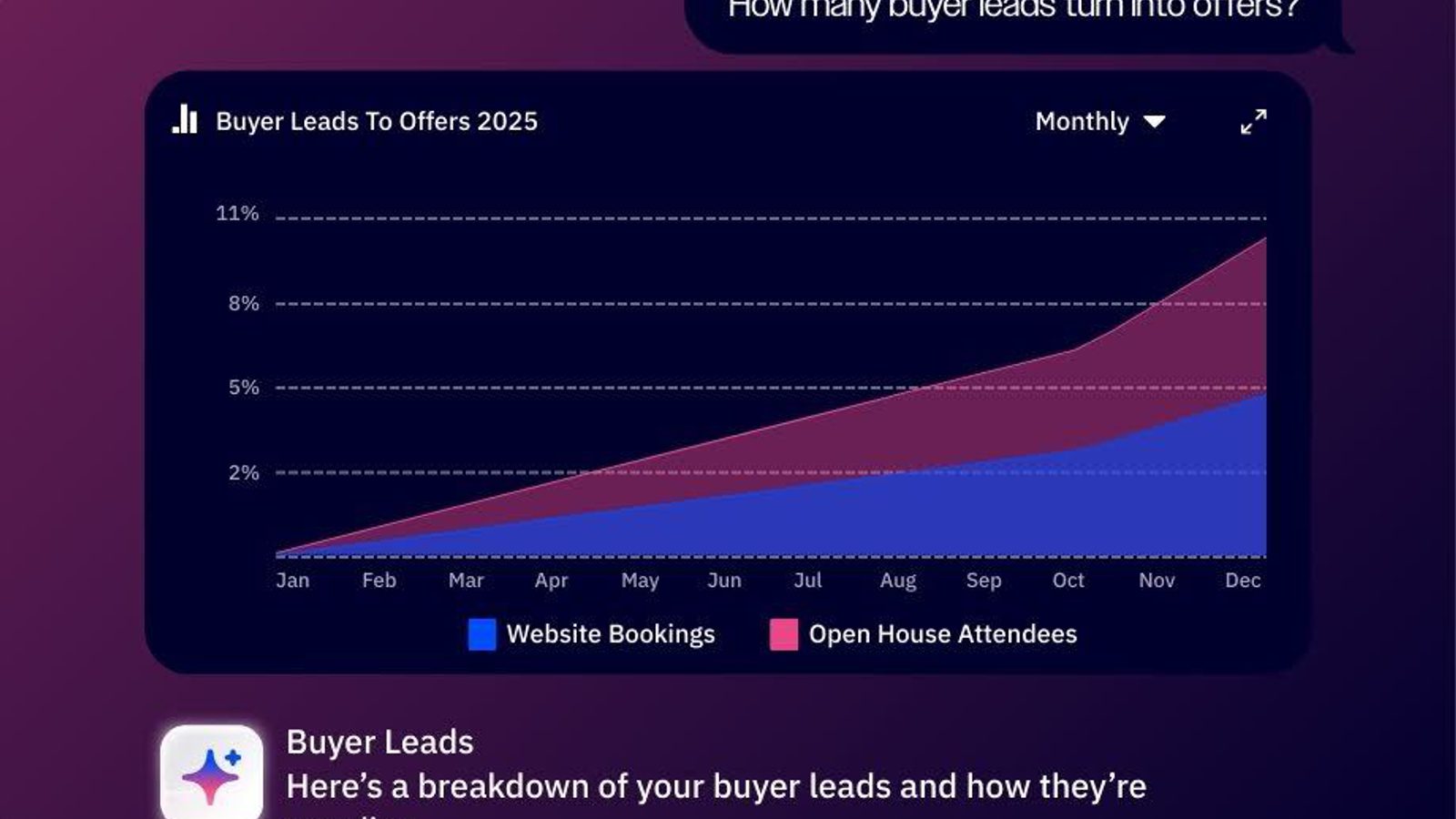In a time when inboxes are full of email blasts asking for attention, the art of the re-engagement email has become essential for businesses worldwide.
Picture this: You've got subscribers who've gradually slipped away from your brand's radar, maybe they haven't opened your emails in a while. This is where a re-engagement email (also known as a win-back email) is the most effective to rekindle fading connections and reignite customer engagement.
At the heart of a successful re-engagement email lies a compelling subject line. Crafting a powerful subject line is no mere formality; it's an art that entices, intrigues, and captures the recipient's attention (and hopefully beats out all the other emails waiting to be read).
There are various factors to consider when writing re-engagement email subject lines. It must incite curiosity, be relevant to each customer, and include a dash of FOMO (fear of missing out) that compels the reader to take action.
The importance of re-engagement email subject lines
The significance of a re-engagement email is more than just rekindling the customer's attention. It can potentially be a driver of sales and revenue for your business.
One study reported that 47% of email recipients open emails solely because of the subject line.
Each re-engagement email subject line is a chance to showcase your brand's evolution, announce new offerings, or sweeten the deal with enticing incentives in a short and punchy way. With a tailored approach that caters to each recipient's preferences and behavior, re-engagement emails have the power to rekindle the desire to explore, purchase, and ultimately contribute to the growth of your business's bottom line.
Don't leave that money on the table.
Click here to learn more about the importance of email preheaders.
The purpose of a re-engagement email campaign
There are two main reasons why you should consider crafting a meticulous re-engagement email campaign. Other than the opportunity to capture nearly lost revenue, the entire campaign will strengthen not only your brand image but the relationship you're fostering with your customers.
Capture tuned-out customers
Re-engagement email campaigns aim to recapture the attention of customers who might have drifted away. These emails remind lapsed customers of the brand and usually share exciting updates, showcase new products, or offer special deals in order to reignite that spark of interest and encourage customers to come back and explore what they've been missing. They create a bridge to rekindle the connection and draw lapsed customers back into the fold.
When looking at your own email list, there are a few ways to identify the group of customers who may need to be re-engaged. Using ActiveCampaign as an example, you're not only able to see each customer's data including location, email address, preferences, purchase history, and more, but you can also use the segmentation functionality and filter your lists based on four activity statuses. These include Active, Unconfirmed, Unsubscribed, and Bounced.
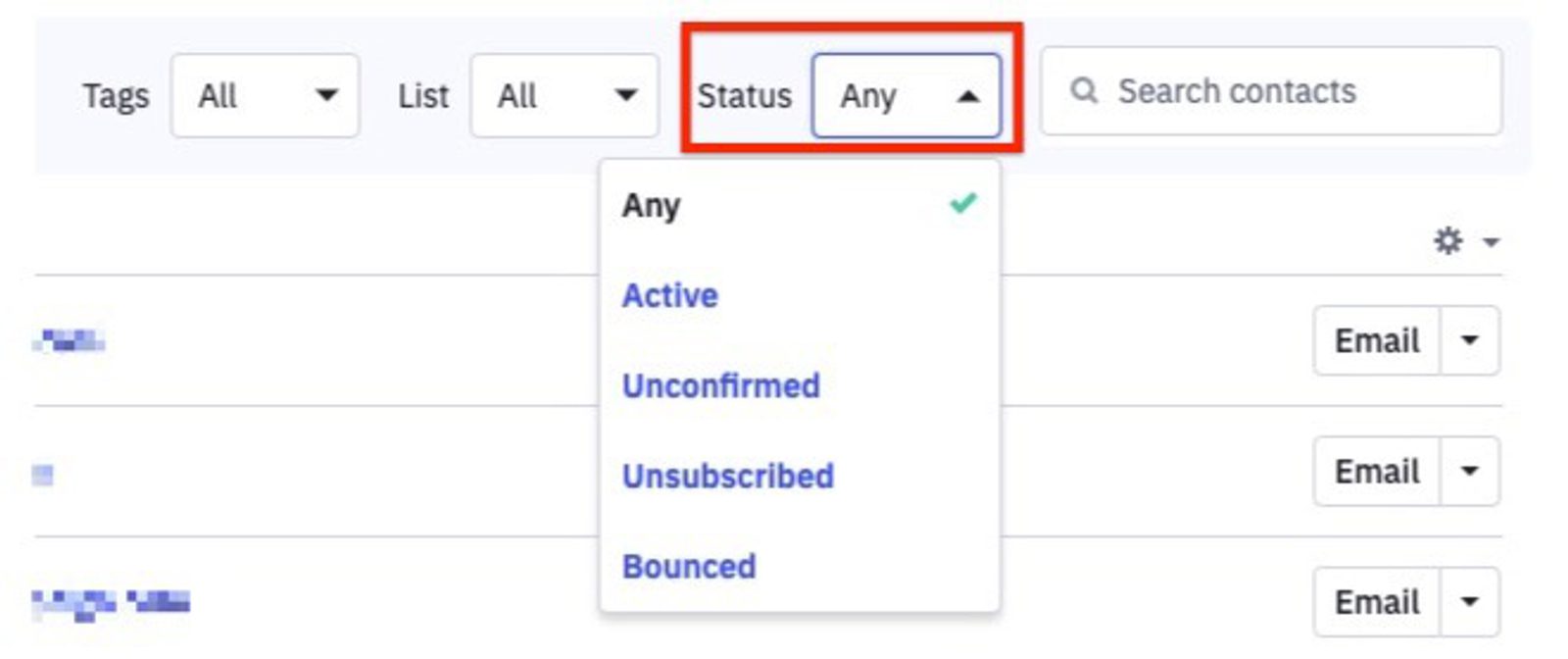
Note: Active customers do not always equal engaged customers! The active status simply means that the contact has confirmed their subscription to your site, newsletter, etc. This means that to discover who needs to be re-engaged, you'll need to do a bit more digging. ActiveCampaign gives you the power to add "Disengaged" tags to customers who don't open your emails or click on the CTA links inside. Once a customer has this tag, you can set up an automation that will send a re-engagement email to these straying customers and pull them back in before it's too late.
Strengthen your email list
Sending a re-engagement email sequence not only gauges the interest of your customers but also offers businesses the opportunity to streamline their email lists and remove customers who might have lost interest or moved on. By reaching out to those who haven't been engaging, businesses can separate the genuinely uninterested from those who still hold a flicker of curiosity. It's a smart way to ensure that the email list remains filled with customers who truly care about the brand and want to stay connected.
Maybe you'll see that 112/200 opened your re-engagement email. You can then send a follow-up email (perhaps with a discount code or special offer) to double-check who's in and who's out. After this, it's up to you to decide if you'll remove the customers who didn't open your email or even organize them into another segment that needs extra attention. All of this can be made easier with marketing automation, giving you the power to be nearly hands-off while remaining relevant and personal.
Note: Although it's important to re-engage, you should never continuously spam your customers with re-engagement emails. If they haven't opened your emails in well over six months, it may be time to clean them from the list altogether.
Re-engagement email subject line best practices
Let's go deeper. When it comes to crafting re-engagement email subject lines, a little creativity can go a long way. Think of it like catching someone's eye in a busy crowd. Keep it short, intriguing, and personal. A touch of curiosity or a hint of something exciting can spark their interest. Remind them of what they might be missing or offer a tempting peek into what's new. Remember, a well-crafted subject line is the key that opens the door to your email, so make it worth their while and give them a reason to click.
Make it urgent
One of the most powerful techniques you can use when writing re-engagement email subject lines is to create a sense of urgency. Doing so catches the customer's attention and nudges them to take action. Urgency makes you wonder if you're missing out on something cool. It goes hand in hand with FOMO.
Crafting urgent subject lines is important because it gives recipients a little push to open the email and see what's happening. When they feel like time is running out, they'll be more likely to engage (and re-engage!)

By using automation sequences in ActiveCampaign, you can set up a flow that follows a contact through their buyer journey. For example: You see that a contact visits your site and clicks around your booking page. They leave or close the browser for a stretch of time. This is the perfect opportunity to create urgency. By setting up this workflow above, you can automatically send an email with a "Limited Time Offer" subject line to each person who visits the booking page.
In this example, both parties win.
Make it personalized
Personalization works in any subsection of communication, from texts to Tweets to newsletters.
A study reported that targeted email marketing (particularly personalizing your subject line) can boost open rates by up to 50%. Plus, emails that include the reader's name in the subject have 7% higher open rates than those without.
Personalizing your email subject line adds a human touch and shows the customer that you care about tailoring their experience. It's really quite simple. It's a way to tell them that you acknowledge their presence instead of addressing everyone as one conglomerate. A personalized approach transforms the email from a generic broadcast to a meaningful interaction, fostering a sense of intimacy between the brand and the customer.
Going further, you can recognize individual preferences or past interactions and turn your subject line into a conversation starter. This connection-building tactic cultivates a deeper level of engagement, where recipients feel valued and understood, incentivizing them to explore the email content and forge a stronger relationship with the brand.
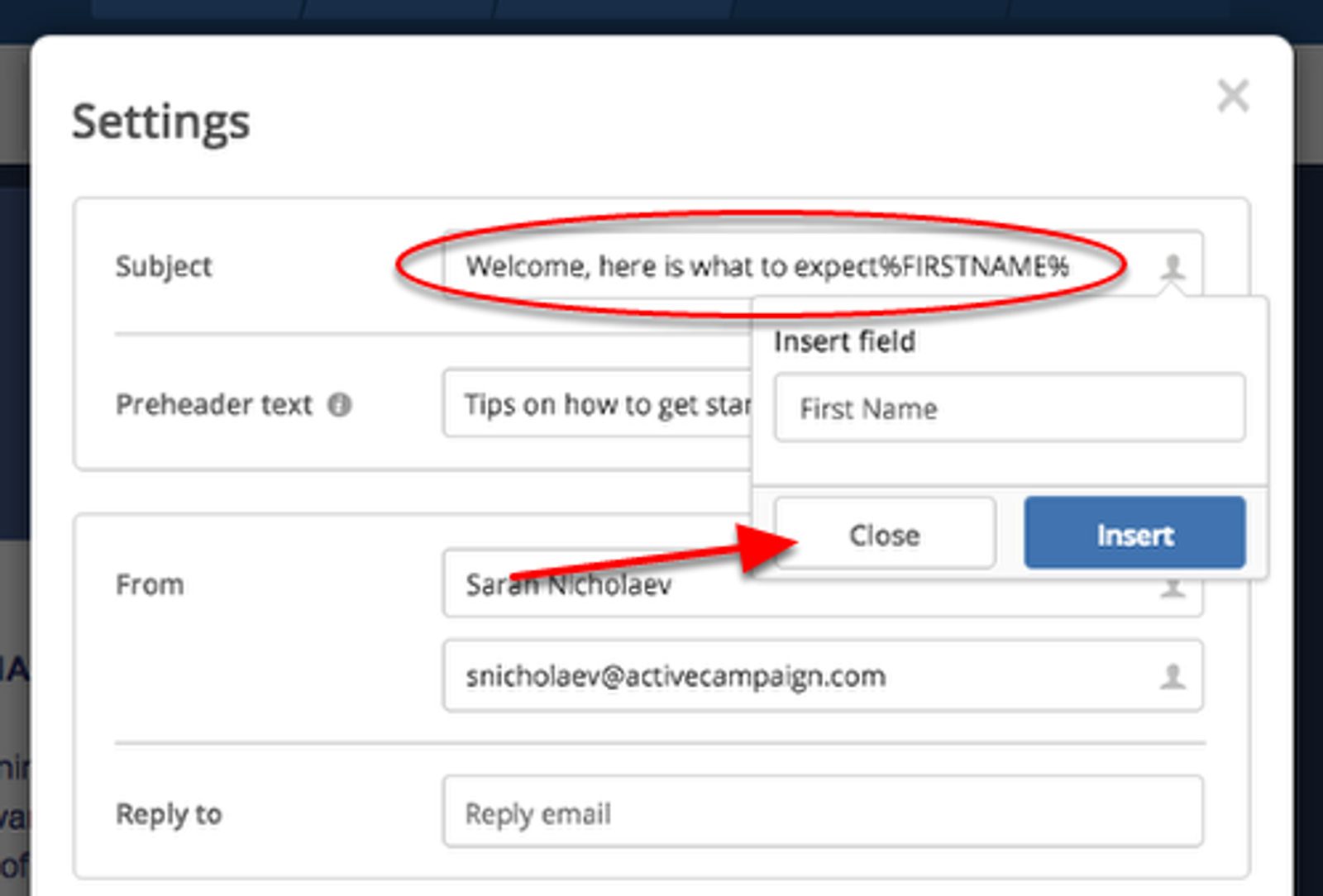
Demonstrate clear value
Did you know that 59% of all consumers feel as if businesses have lost touch with the human element of the customer experience? Today, customers are expecting more from the brands and businesses they support and naturally, they want to feel like the brand is solving a problem for them.
At the end of the day, people invest in your product or service to make their life easier.
When you write your re-engagement email subject lines, it's crucial to show why your brand or product is worth their time and money. Think of it as giving someone a reason to care. When you highlight the benefits and show how your product can solve a problem they need fixed, you instantly become an option. If a customer has been absent, they need to be shown why they should come back. By fixing a problem for them, they'll be more likely to consider you when it's time to make the purchase.
Your subject line is the first impression, and by showcasing the value you offer, you're giving them a reason to open the email and explore further. How does your brand stand out from the rest? Are you innovating in a way no other brand is? Do you offer your customers regular freebies, whether that be a free PDF guide on email marketing or a 15% off coupon on your entire store? All of these things can be included in your subject line to prove the value only your brand can provide.
Whether it's saving time, making things easier, or adding a special touch to their life, the subject line is where you lay the groundwork first.
Simplicity is key
Simplicity is powerful.
A clear and to-the-point re-engagement email subject line acts as a clear signpost that points recipients in the right direction. In a world filled with distractions, a simple subject line stands out and grabs attention instantly. It conveys the main idea without overwhelming the reader. By keeping it concise and uncomplicated, you say more with less and make a compelling case for engagement in just a few words.
Keep in mind: Once the recipient clicks into your email, the copy and CTA should be simple as well. Our attention spans have shrunk so it's crucial to make the most of the short engagement time each recipient will give you. Be sure your CTA is obvious. Don't send an email that's five paragraphs long. Prove value and do it quickly.
Give them something
We've touched on this a bit but it can't be excluded from our list of best practices. People are more likely to interact with your email if you offer an incentive. Say you're hoping to re-engage some silent customers and attempt to get them to sign up for your newsletter. To increase the chance of someone signing, you can offer things like a discount code, a free gift card with purchase, a limited-time price, a free month's trial, etc. in return for their subscription. In your email subject line, use words like "Discount code" or "$10 when you subscribe". People like free stuff. Use it to your advantage when re-engaging them.
Another idea would be creating a truly engaging newsletter. Newsletters should lay out helpful information like blog posts, guides, and free assets that customers can use to power their own growth. A great newsletter provides value before asking people to buy a product or service. Give value, build a relationship with your audience, and then experiment with different ways to lead them down the funnel.
Designing a newsletter? Click here to see newsletter designs you can use to engage your email list.
Product recommendation
Maybe it's been a while since the customers you're trying to re-engage have purchased anything from you. In order to capture their attention again, consider recommending them products based on their previous purchase history. It's a safe bet to guess that they're not aware of your latest product updates or your recent launches. Sending them a recommendation to "Check XYZ out!" is a great way to keep them in the loop and tempt them to click on a link to your site and see what's new.
The 9 best re-engagement email subject line examples
You can find a long list of re-engagement email subject line examples by doing a quick Google search. Here are our top nine re-engagement subject line examples that are punchy, effective, and worth taking some inspiration from.
The discount subject line
Subject line: Here's a 90% discount to get you back on track

Why it works
It's no surprise that this is at the top of our list. This re-engagement email from Noom is a textbook example of the discount re-engagement email subject line. To reignite the flame with lapsed customers, they offer a generous discount of 90% and a free trial which both serve as an incentive to prove their appreciation and dedication to their customers. And to highlight the power of a discount re-engagement email subject line, you'll be happy to hear that 75% of consumers search their inboxes for relevant discounts. It's a proven re-engagement technique backed by data!
The "We miss you!" subject line
Subject line: We've missed you!
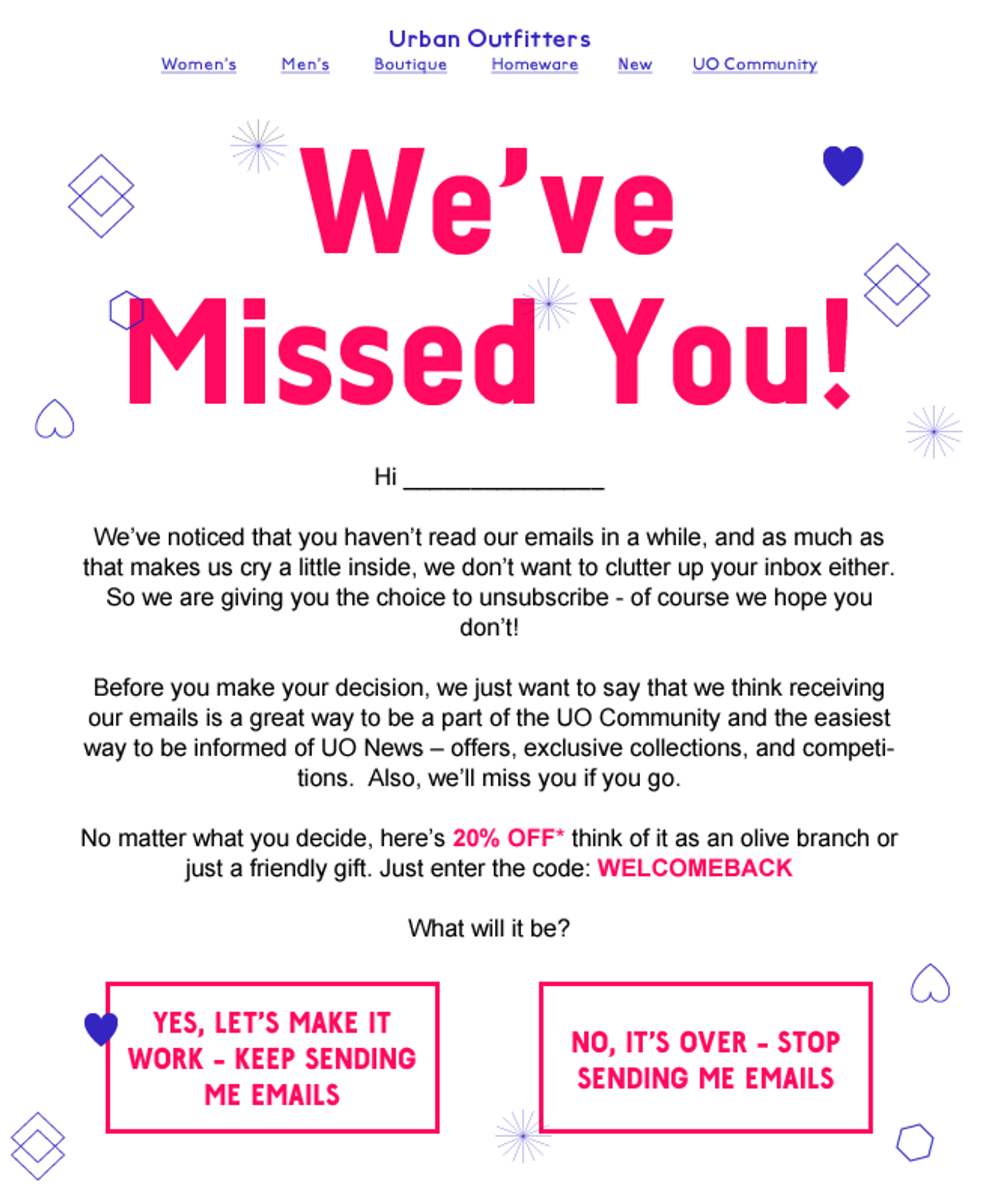
Why it works
This re-engagement email from Urban Outfitters is a great example of two things: the We've Missed You email subject line and giving inactive subscribers the choice of whether or not to continue receiving marketing emails. As if that's not enough, they throw in a 20% off offer to sweeten the deal. These three techniques combined make the customer feel in control (they have the choice whether to stay subscribed or unsubscribe), connected (the brand is missing them), and appreciated (the 20% off coupon shows that the brand cares more about keeping them as a customer than selling products at full price).
The product feedback subject line
Subject line: We want your opinion. How can we make Grammarly better?
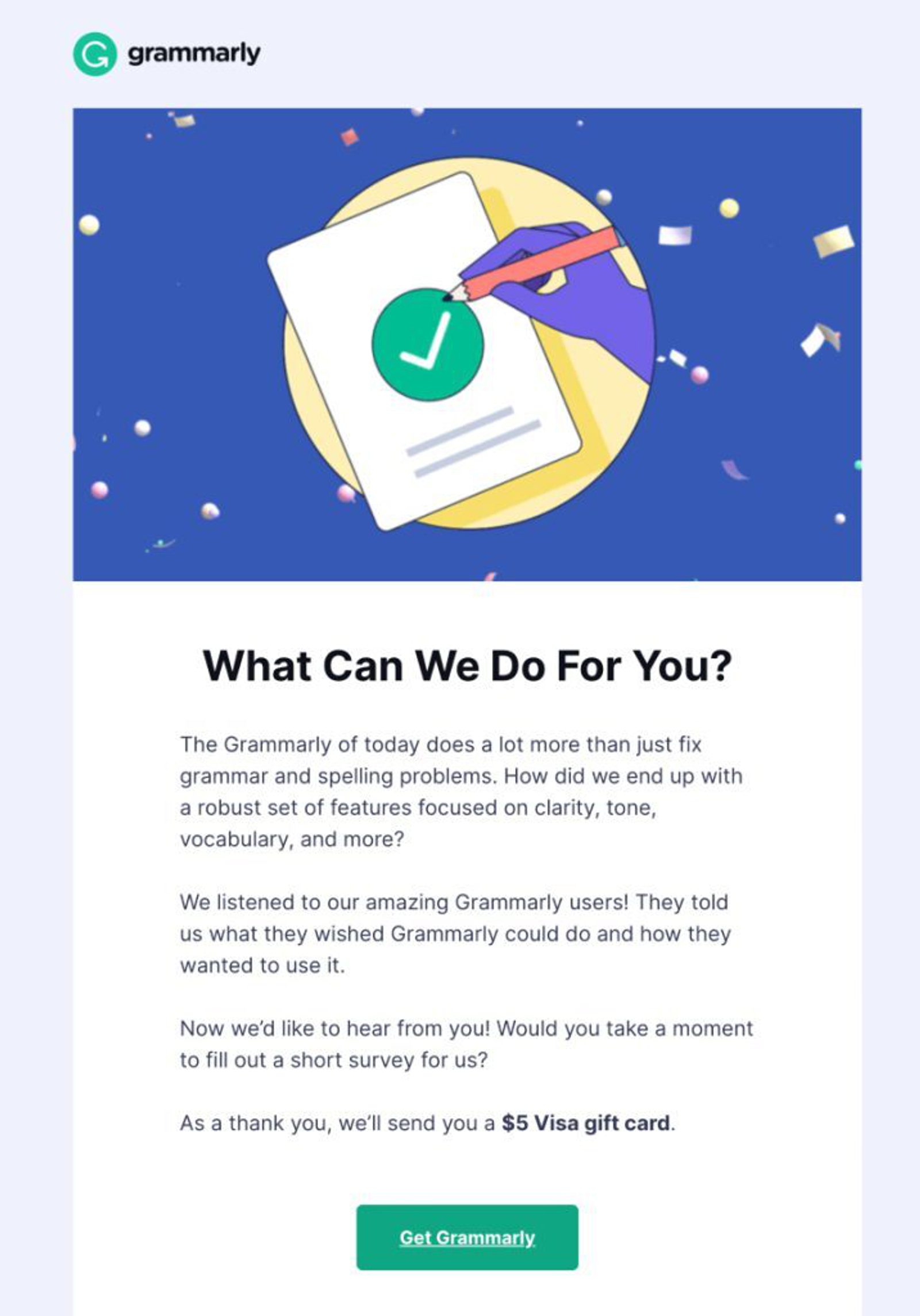
Why it works
This re-engagement email from Grammarly puts the recipient at center stage by asking how they can improve their product (with a $5 Visa gift card incentive). Lapsed customers may see this re-engagement email subject line in their inbox and feel emboldened to be shockingly honest. While this opens the door for criticism and telling it like it is, Grammarly wins because they field honest feedback, maybe the most honest feedback by sending this email to customers who haven't used the product for a while and have a reason why they lost interest. The product feedback email is a great way to re-engage those inactive users and show that the brand cares about what they have to say.
The FOMO subject line
Subject line: TONIGHT ONLY! Save up to 20% EXTRA during MIDNIGHT MADNESS

Why it works
Studies show that FOMO not only increases your open rates, but it can also boost conversions. A whopping 68% of people have made a reactionary purchase because of FOMO. Like a lot of our examples, this email from Sears (RIP) uses urgency and an incentive to create a sense of FOMO that has the power to bring even the most unengaged customer back into the fold.
See a trend? People act when they're offered a discount.
The product update subject line
Subject line: Have you seen our new app? Come see what's new
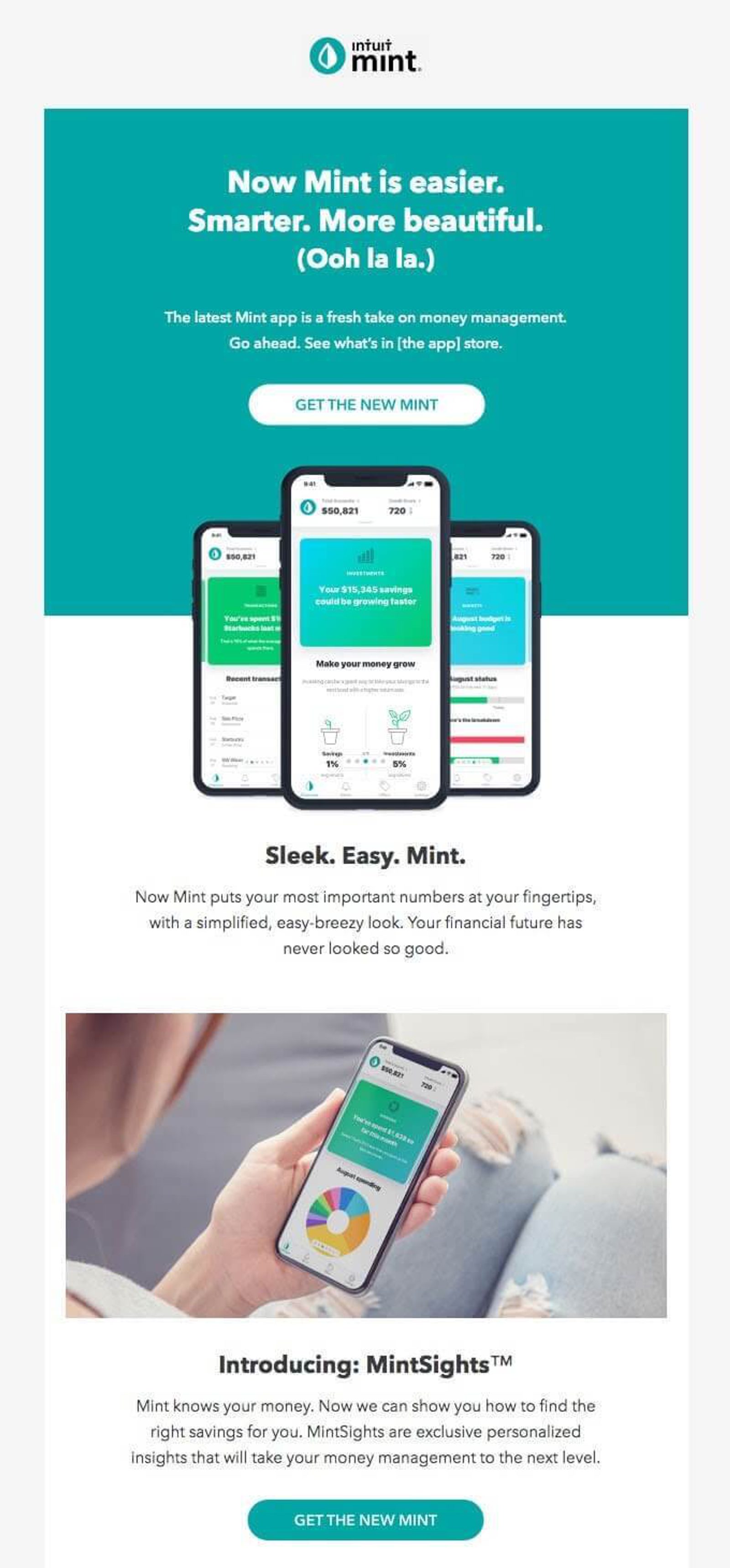
Why it works
Mint sent out this re-engagement email to announce their new app as well as a few new features for their users to start taking advantage of. The subject line "Have you seen our new app?" sparks curiosity right off the bat and nudges inactive users to open the email and see what's new. With a sleek and clean email design, Mint showcases how easy it is to use their app, ultimately boosting click-through rates to their site and successfully re-engaging the list of disengaged customers.
The "Don't lose access/points/etc" subject line
Subject line: Use your rewards points before they expire
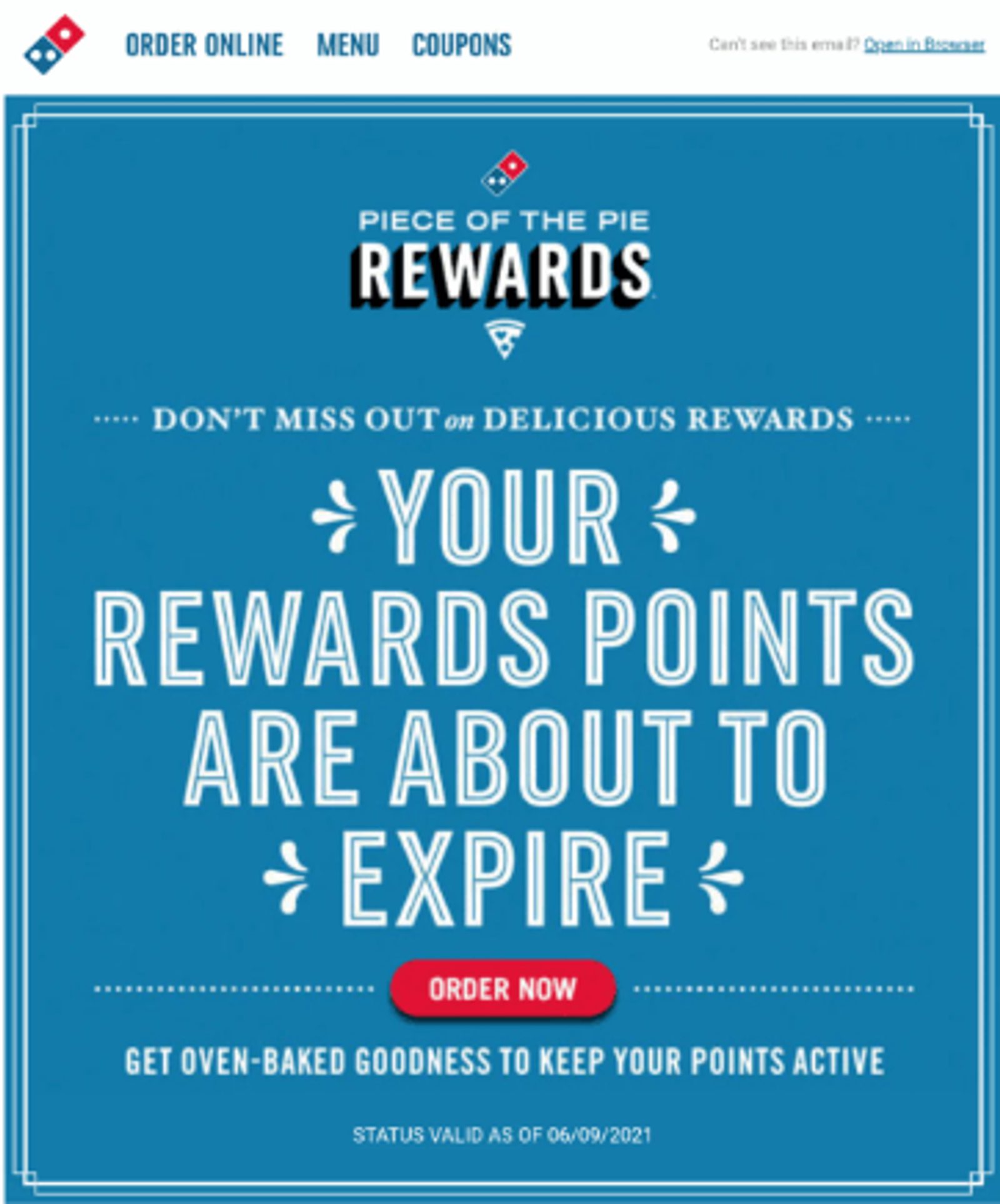
Why it works
Food delivery services can especially benefit from using re-engagement email subject lines like this one from Domino's. There's that familiar sense of urgency to "use your rewards points before they expire", making the customer seriously consider purchasing a discounted pizza before they don't have the chance to anymore. And who could resist an offer as delicious as this?
The last chance subject line
Subject line: Offer ends tomorrow! Your last chance for 3 free months of Starter

Why it works
This email from Zapier is the perfect example of how to re-engage an inactive subscriber. The urgent "Offer ends tomorrow!" included in the subject line works by encouraging former customers to sign up for a trial. Once the recipient's interest is piqued by the subject line, they see a short bulleted list of what they have access to when signing up for a Zapier plan. All of these ingredients strung together are a great technique for a re-engagement campaign.
The apology subject line
Subject line: We're sorry. This is our last email to you
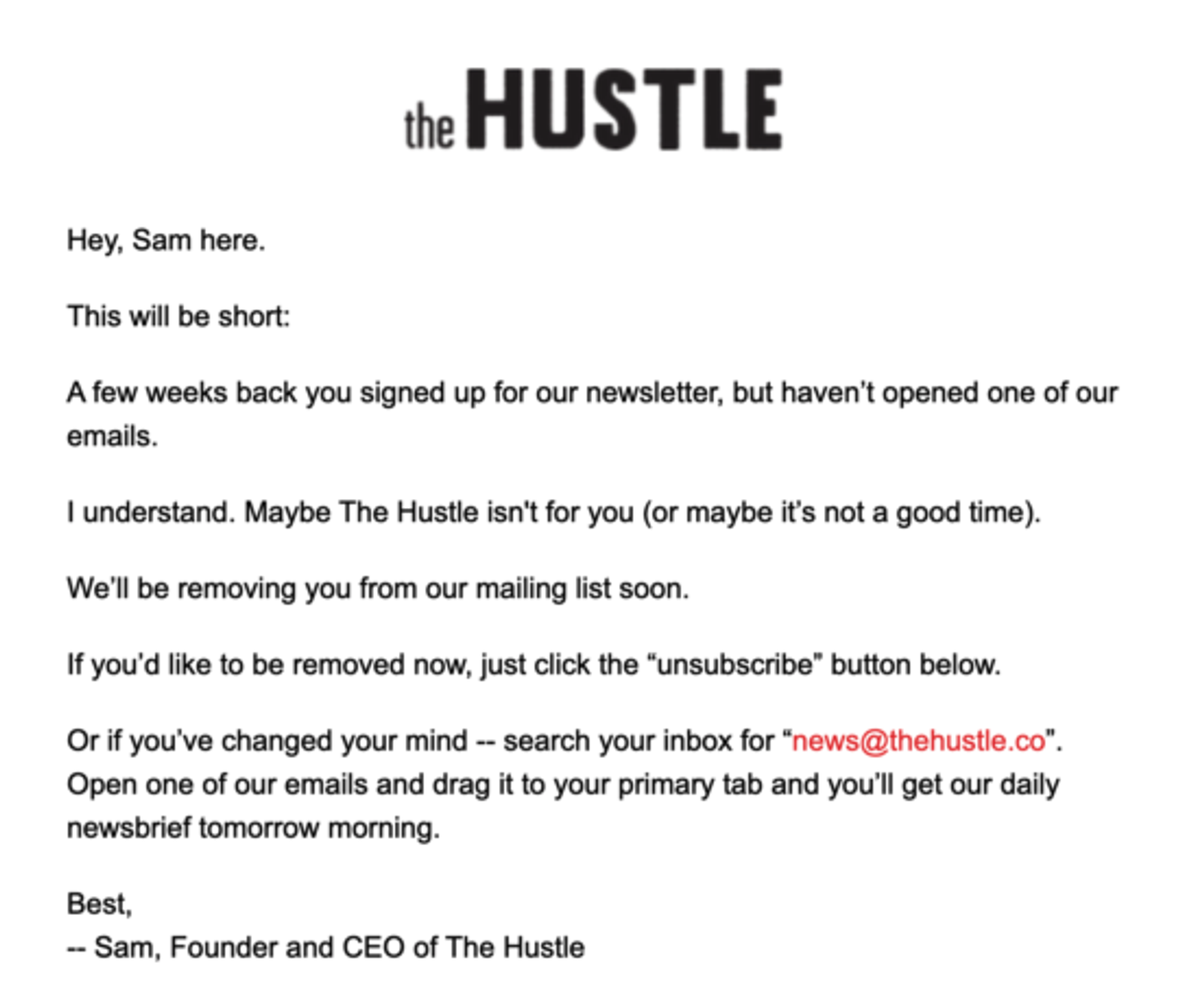
Why it works
This email from the Hustle showcases the apology subject line as well as another interesting technique. The "have you changed your mind?" technique. With the subject line being "Our last email to you", there's a sense of curiosity a recipient would likely feel when they see it in their inbox. When inactive customers open it, they'll see the brand understanding that they haven't engaged in a while, letting them know they'll be removed from the mailing list soon, and are given the option to unsubscribe or stay in the loop. This email accepts the customer's choice but also leaves it open-ended, showing that the brand knows everyone is busy and things slip through the cracks. It's a very human way to push the customer to give the newsletter another go.
The follow-through subject line
Subject line: You're almost there! Finish signing up and start watching today
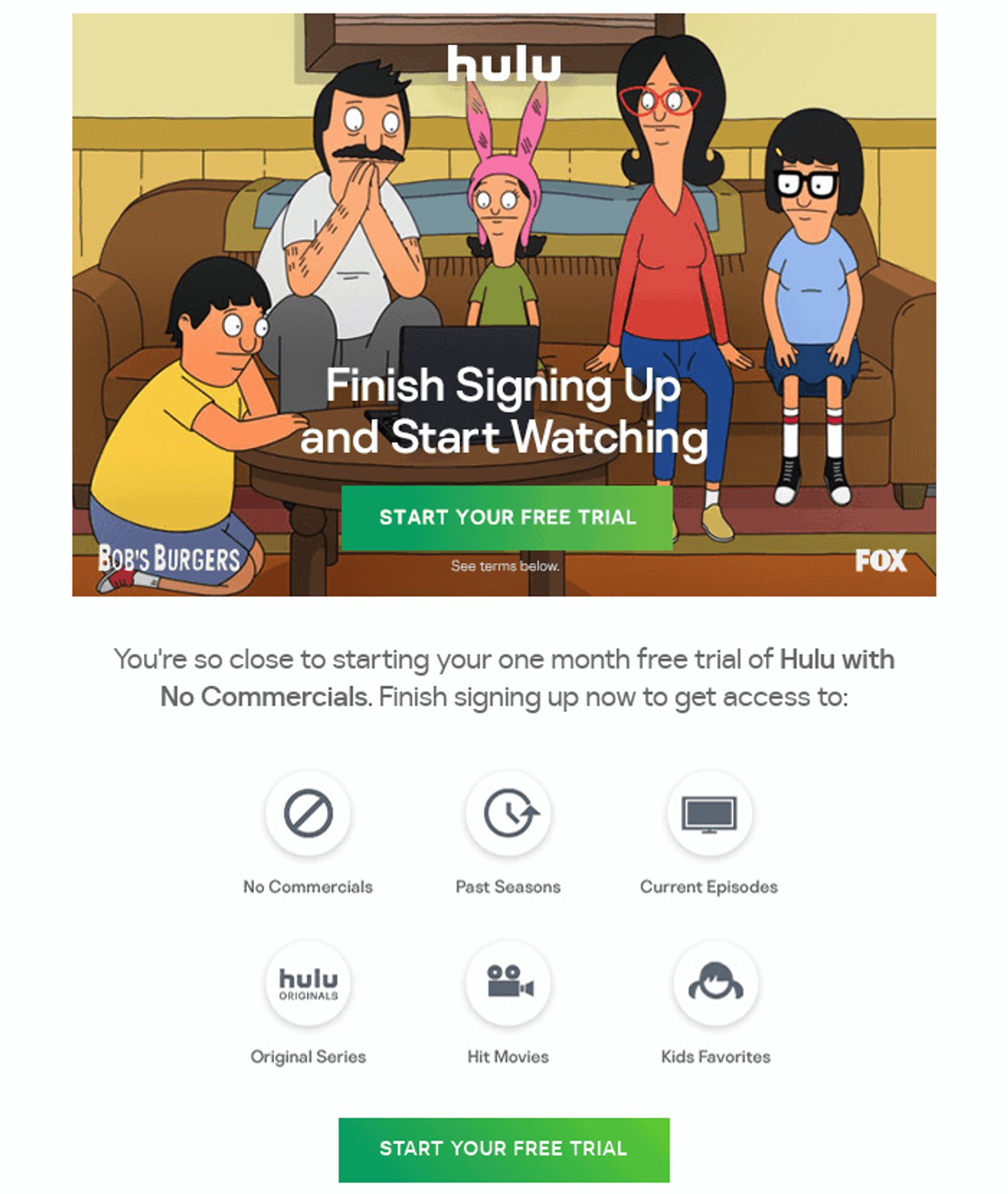
Why it works
Similar to an abandoned cart email, this re-engagement email works well and here's why. This recipient started signing up for a Hulu account and for some reason or another, didn't finish doing so. By sending this re-engagement email, including encouragement like "You're almost there!" in the subject line, and highlighting their features, Hulu gives the recipient motivation to finish signing up so they can enjoy all that the streaming service has to offer.
Ready, set, re-engage
It can feel overwhelming to try and re-engage your customers who have essentially become ghosts in your email list but don't give up on them. By taking some inspiration from the examples above and incorporating some best practices, you'll be able to write an effective re-engagement email subject line and boost your chances of bringing those customers back into your brand's orbit.
Now that you've written a great email subject line, you'll need to know how to format different types of emails. Each email has an objective and are different from other types so make sure you brush up on your knowledge.
Try ActiveCampaign out for free and sign up for a trial in the box to the right →



